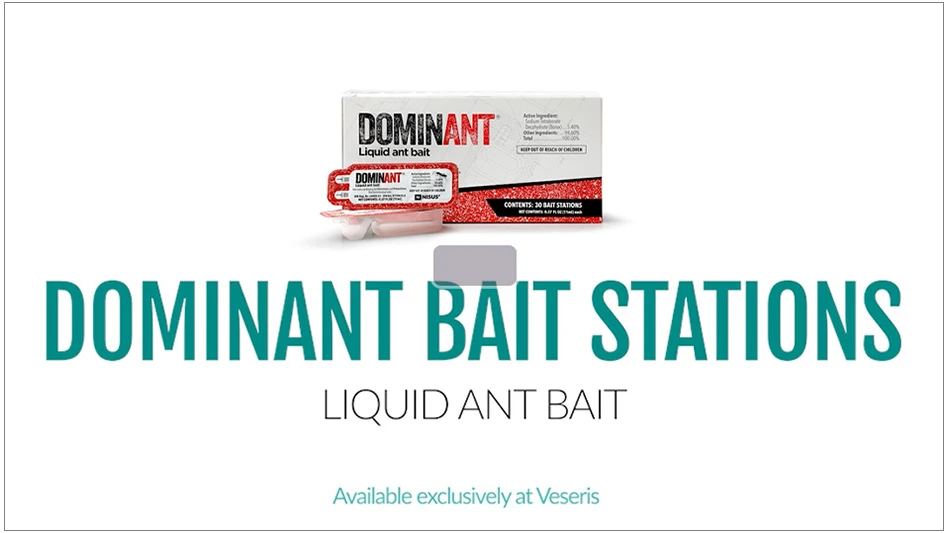At his last account of the day — a high-rise apartment unit — Vincent Esposito, vice president of Complete Pest Control, East Rockaway, N.Y., and a PCO with 18 years of experience, scratched his head and looked on in bewilderment.
|
|
Esposito had applied a cockroach gel bait into a crevice with an active German roach infestation and then watched in amazement as the roaches scurried away from the bait.
How was this possible, Esposito wondered? He and his company had been using cockroach gel baits since the products were introduced in the mid-1990s. In the last seven years, Esposito and his technicians had become skilled at using baits and making proper placements. Moreover, to ensure the baits’ effectiveness, Complete Pest Control had been rotating them quarterly. In other words, every three months or so, the company would replace an account’s existing bait with new bait from various manufacturers.
His initial encounter with a baiting problem occurred two years ago. Since then, Esposito has tracked similar encounters. As equally puzzling as the baiting failure was the frequency at which these problems were occurring. For most of his accounts, gel baits were still working wonders; however, in a few accounts — perhaps one out of 10 — German cockroaches were no longer "taking the bait."
Across town, in suburban Spring Valley, N.Y., Larry Siegal, owner of The Bug Runner Exterminating Co., had been experiencing similar difficulties the last six months.
"We first started seeing it in smaller ‘mom and pop’ food-handling operations where sanitation might not be as good as the larger accounts," Siegal said. "Now we are seeing it across the board, in apartment buildings and warehouses. I think it is because now the (bait-averse) roaches are being transferred."
Siegal, a 30-year industry veteran, has been visiting many of these problematic accounts in the last six months. He’s treated accounts with as many as four different products from four different manufacturers. "We are getting some control doing this, but it has not been as extreme as it used to be," Siegal said. "Before, we would place the baits, and just like that, the roaches were gone."
Lest you think this is a problem just in New York City, there are other nationwide examples. Frank Meek, national pest control technical manager, Orkin Technical Services, Atlanta, Ga., says his company’s branch offices have reported pockets of roach problems throughout the United States, including all major markets in Texas; areas south of Orlando, Fla.; Jacksonville, Fla.; Atlanta; throughout the East Coast, including Washington, D.C., and New York; Chicago; and several locations in California. "We’re seeing it in most major metropolitan areas," he said.
"It’s a big problem but not a big problem at the same time," Meek said. "It’s not widespread — you can’t say that every customer we’ve baited has this problem."
Meek has surveyed his company’s offices and found 1 to 5 percent of the total customer base in a branch may have roach populations that can’t be controlled by baiting. "Those are large numbers, but small percentages," he said.
WHAT IS GOING ON? PCOs contacted by PCT who are experiencing cockroach gel baiting problems have reviewed their company’s past work to search for clues.
Have we applied an ample amount of bait? Have we baited the proper places? What did I do differently this month than in previous months? Have we rotated baits regularly? Have there been any structural changes? Has sanitation steadily worsened? These were some questions PCOs asked themselves in the wake of baiting failures.
Some patterns can be found among PCOs who have been experiencing German cockroach baiting difficulties recently. In general, progressive PCOs — the ones who began using German cockroach gel baits when they were introduced — were the ones experiencing the problems.
These PCOs continually used baits over the last seven or so years, and, many of them rotated baits. For the better part of the last seven years, baits were providing consistently outstanding results. The baits were working so well, in fact, that they were the primary tool used to control cockroaches. It wasn’t until the last six months to two years that PCOs began witnessing cockroaches that weren’t "taking the bait."
"We’ve been getting reports of problems the last 12 to 18 months," said Mike Deutsch, technical director of Manhattan-based Assured Environments. "Prior to this, you would put the baits out and the roaches ran to it and you eliminated the problem. Now some of the roaches seem to be passing it. "
A knee-jerk reaction among many PCOs was that the technician servicing the account had "an off day." But many of those same PCOs later were proven wrong.
"One of my technicians said, ‘Hey, (the gel baits) are not working,’ so I went and checked it out and German cockroaches were nesting right next to where the bait was put out," Esposito said. "I can’t blame my technicians."
RESEARCH PERSPECTIVE. PCT contacted six leading urban entomology research professors in the U.S. to discuss the issue of cockroach bait aversion/resistance. The consensus was that pest management professionals were providing some anecdotal evidence of German cockroach bait resistance. Furthermore, none of the six had, or was in the process of, conducting research to determine if reported resistance was occurring.
Dr. Dan Suiter (University of Georgia) conducted an informal survey of 20 experienced technicians and found several were convinced that baits were not as effective. Drs. Phil Koehler (University of Florida), Dini Miller (Virginia Polytechnic Institute and State University) and Coby Schal (North Carolina State University) have heard similar comments from their constituents. Don Reierson (University of California, Riverside) indicated PCOs in his area were not reporting problems with baits.
Dr. Gary Bennett (Purdue University) summed up what PCT heard from PCOs, i.e., based on lab and field studies, baits are not performing as well as they were 10 years ago. He suggested that pest management professionals practice cockroach bait management — carefully select products and apply them properly.
Following are the few conclusions that can be drawn from the current body of research (because more needs to be done):
• Aversion was demonstrated in earlier formulations of baits containing glucose. (See September 1993 PCT cover story at www.pctonline.com.)
• The potential for physiological and behavioral resistance has been demonstrated in the lab (Don Reierson).
• If German roaches eat any of the currently formulated baits they will die.
OTHER THOUGHTS. As PCOs know, cockroaches easily adapt to their environments. The relatively short life cycle and greater number of offspring per generation make German roaches likely to adjust to their surroundings. Much like the roaches that moved from floor to ceiling when baseboards were frequently sprayed years ago, today’s roaches may have adjusted their way of life to "avoid" cockroach gel baits. (See "Aversion Vs. Resistance," page 29.)
The aversion characteristics discussed previously are similar to others that cockroaches have developed over the years. For example, a few years ago, roaches were found to have an aversion to the glucose component in Maxforce Bait Stations. "There the solution proved to be fairly simple," said Gordon Morrison, marketing manager, general insect control, Bayer Environmental Science. "Maxforce replaced the glucose with another sugar complex. This is a more complicated issue, but we’re confident we have a fix."
Initially, some thought the recent cases of cockroach aversion to baits were along the same lines as the glucose situation. "We figured that when this first popped up it was something similar," said Joe Barile, national technical manager, Maxforce. "So we tried substituting out the sugars but it didn’t work."
HUMANS ADAPT. Much like German cockroaches, the pest control industry has been forced to adapt to this latest challenge. The pest control community has taken steps to correct the baiting problem.
For the past two-plus years, PCOs have been sharing their reports and relating their experiences with manufacturers, distributors, consultants, university researchers and other PCOs. And, in New York City, as well as other parts of the country, PCOs have been collecting bait-resistant German cockroaches for Bayer Environmental Science, manufacturer of the Maxforce gel baits, to study.
Still, some manufacturers are in the initial research stages and it remains unclear if German cockroaches are sensitive to a specific characteristic of the gel baits.
Steve Sims, senior research entomologist for Whitmire Micro-Gen Laboratories, manufacturer of Avert Gel Bait, said more research is needed. "It’s hard to know what to change when you don’t know what the problem is," he said. "We are being very alert and very sensitive to this issue but we don’t know the details of what’s happening. We don’t want to go around willy nilly and change things that may not need to be changed."
Other manufacturers agree.
BASF, manufacturer of Siege Gel Insecticide, said that although much of the current information is anecdotal, the company is interested in learning more about the problem. "News of this development is quite new and in many cases emerging through casual conversation. No firm confirmation has yet been determined," said Chuck Klein, biology project leader — Insecticides and Nematicides, BASF Corp. "With this in mind, BASF is actively monitoring the issue and will take appropriate steps in the event aversion is confirmed."
Bayer is expanding its collection of roaches in order to obtain as many field strains as possible from around the country. Maxforce went through a similar process when it reformulated its hydramethylnon bait after German roaches were showing a glucose aversion.
In the meantime, PCOs also will have to adapt. When German cockroach gel baits were introduced to the pest control industry in the mid-1990s they revolutionized German cockroach control. Traditional forms of German cockroach control, including spraying, applying dusts, aerosols and fogging were greatly reduced and, in some cases, replaced entirely by baiting.
German cockroach gel baits are effective, quick, odorless and safe, making them appealing to PCOs and customers alike. As it turns out, the effectiveness and popularity of baits may have had some drawbacks. German cockroach control became less reliant on good inspections and proper application and more dependent on the product.
"With baits you were able to be lazy," Bug Runner’s Siegal said. "You didn’t have to do a good job to bait. The baits worked so well that the roaches came to it. That was it. Done. There was no trick to it."
In fact, some technicians have been trained to control German roaches using only baits. Thus, some PCOs believe their technicians aren’t as adept at inspecting and using "traditional" control products.
"One of the things the industry as a whole has gotten away from is the basics. The use of dust materials, IGRs, traps, monitors, vacuum cleaners — across the industry — we’ve gotten away from those basics," said Orkin’s Frank Meek. "Where we’ve gone back and retrained those technicians and had them go back and do good basic pest control we’ve been successful at overcoming this issue."
Many PCOs are using traditional control methods, i.e., sprays, dusts and foggers, in accounts where roach baits are not working.
"We’ve encountered a couple heavy infestations in apartments and restaurants where we told people to please remove everything from their cabinets and we will spray them down," Esposito said.
Assured Environments’ Deutsch says his company is only using liquid pesticides as a last resort. In difficult accounts, his technicians are more thoroughly inspecting and doing more intensive baiting using ample amounts of bait and using two or three different types of bait.
"It’s more paperwork for us and more stuff for the guys to carry, but we are doing it in these few instances where we are having these problems," Deutsch said. "Whether or not this works, it’s too early to tell."
It’s important to note, however, that baits — in most accounts — are still performing very well.
"The one thing we’re stressing to our technicians and managers everywhere is that it’s not that the baits are not good — they are still good — if you take over an account that has not been using baits (using conventional materials), bait material still works in those places," Meek said. "The customers who’ve had their facilities constantly exposed to bait materials have these issues."
WHAT’S NEXT? The problems pest management professionals have been encountering the last couple years with German cockroaches avoiding baits in certain accounts is a reminder about this pest’s amazing ability to adapt.
It’s still too early to tell if recent baiting failures are definitively the result of German cockroaches exhibiting behavioral or genetic resistance to gel baits. It is clear, however, that the industry needs to examine its cockroach control methods. But how big will this problem become in the future?
"It’s certainly not widespread in our company now," Deutsch said. "At this point I don’t think it’s a case of hard resistance, like we saw with rodenticides."
But, it’s enough of a problem that it is impacting some PCOs’ bottom lines. Siegal estimates he is seeing failures in 10 to 15 percent of his accounts. "It’s in enough places where I wouldn’t say it’s ‘isolated,’" he says. "In these accounts we are having to go back two or three times a month. It used to be that we could get control if we treated it once a month."
Recent bait failures also illustrate a shortcoming in technician training. Technician training may need to put more of an emphasis on keeping accounts sanitary, conducting more thorough inspections, harborage treatments and maybe even using more "traditional" products, such as dusts. Proper use of baits, including using correct amounts in appropriate locations, must continue to be emphasized.
In short, recent baiting problems illustrate just how quickly German cockroaches can adapt.
"As Austin Frishman always says, ‘If it comes down to the roaches and the humans, my money is on the roaches,’" Deutsch said. "Roaches always win."
Editor’s note: The charts in this story are based on an e-mail survey PCT sent to 2,051 PCT E-newsletter subscribers on Dec. 6 and Dec. 13. There was a 10.2 percent response rate.
The authors are PCT managing editor; technical director, American Pest Management, Takoma Park, Md.; and PCT editor, respectively.
|
Aversion vs. Resistance
Some in the industry have referred to the current problems being experienced by PCOs in controlling cockroaches with gel baits as “aversion” while others have used the term “behavioral resistance.” For the purposes of this article, “aversion” is a non-genetic characteristic of roaches that avoid gel baits. Many consider aversion to be a precursor to behavioral resistance. “Behavioral resistance,” on the other hand, occurs over time when through a process of natural selection, a group of roaches becomes resistant to baits. Behavioral mechanisms include repellency, avoidance and habitat isolation. There has been little research done in the lab to determine what’s at play here, unless one considers proprietary research. “What we’ve learned from several years of research is that these problem roaches eat less and mature more slowly,” says Don Lesiewicz, passive treatment specialist for Bayer ES. “In addition, our studies indicate that they pass on the bait-averse characteristics to their offspring, which would indicate it’s genetic-based.” These resistance mechanisms have been well documented with traditional insecticide formulations and older active ingredients. Until recently, none of these mechanisms has been suspected as playing a role in control failures with baits. The assumption has been that if a PCO places bait close enough to roaches they will eat it. This may no longer be true. |
USING BAITS CORRECTLY
Of all formulations, baits have become one of the most popular and widely used for controlling cockroaches. Using baits in an IPM program is appealing because they offer long residual life, result in targeted application, provide less environmental contamination and can be used in sensitive environments. Baits require careful placement to be effective.
Here are some tips to follow when baiting for German cockroaches:
• Nothing can replace an efficient and thorough inspection.
• Cockroaches like to follow structural guidelines, such as edges and corners, therefore, PCOs should inject gel and powder baits into cracks and voids where cockroach activity is present or is indicated (e.g., fecal smears).
• Apply small amounts of bait in numerous locations as opposed to large amounts of bait in a few locations.
• Be aware that it is often easy to apply too little bait where larger cockroach populations are encountered.
• Although research has shown that application of baits into areas where other insecticide formulations have been applied is not as great a problem as once feared, it is still better to apply baits alone.
• Create your own "cracks" to apply baits where no cracks exist.
• Vacuum as many cockroaches as possible prior to baiting. Fewer cockroaches ultimately require less bait to achieve results.
• Store baits appropriately (out of extreme heat or cold; away from other insecticides).
• Rotate baits, as well as use bait stations.
• In situations where a gel or powder bait isn’t recommended, bait stations may be used.
• Replace bait stations at least every three months

Explore the January 2003 Issue
Check out more from this issue and find your next story to read.
Latest from Pest Control Technology
- Envu Announces Lichtenstein as Chairman of Board of Directors
- Spider Expertise, Cockroach Species, AI Tools for Disease Transmission Hot Topics at Purdue Conference
- Rose Pest Solution Promotes Kandler to District Manager of Columbus (OH) Office
- Webinar: Maximizing Cash Flow — Key Strategies for Business Growth
- WorkWave Announces Wavelytics
- Rising Rat Populations Linked to Warming Temperatures, Urban Growth, Study Finds
- How Might the 2024 Elections Impact PCOs
- Keeping Track of Termite Identification






